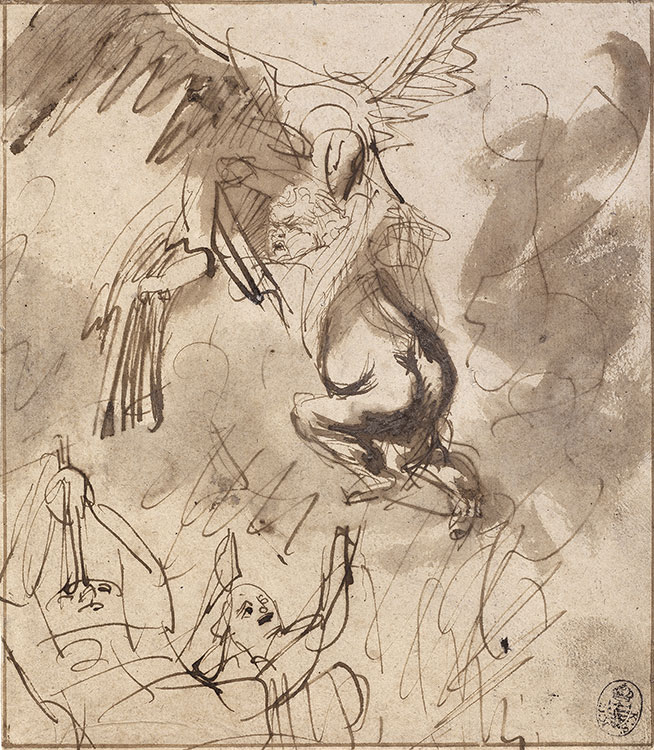
In this drawing, Zeus (known as Jupiter in Roman mythology), disguised as an eagle, abducts Ganymede, a young Greek hero hailing from the city of Troy. Although Ganymede was admired for his unmatched beauty and often depicted in an erotically charged manner, Rembrandt characterizes him as a frightened, unruly toddler who squirms and screams as Zeus carries him away. The artist’s exuberant marks range from bold, zigzagging lines, which delineate the eagle’s body, to the loose swirls on the right side of the composition, which do not seem to serve a specific descriptive function. The drawing was used as a preparatory study for Rembrandt’s painting The Abduction of Ganymede, which is also part of the Dresden collection.
Rembrandt van Rijn
Dutch, 1606–1669
The Abduction of Ganymede, ca. 1635
Pen and brush and brown ink
Kupferstich-Kabinett, Staatliche Kunstsammlungen Dresden, INV. NO. C 1357
© Kupferstich-Kabinett, Staatliche Kunstsammlungen Dresden
Photo: Herbert Boswank
Austeja Mackelaite, Annette and Oscar de la Renta Assistant Curator of Drawings and Prints
In the mid-1630s, the young Rembrandt enjoyed a high point in his career. He had recently moved from his native Leiden to Amsterdam, where he joined the local painters’ guild and began to practice as an independent master. Drawings from this period exhibit dynamism, bravura, and freshness of observation. As we look closely, we are able to witness Rembrandt’s imagination at work by tracing the quick movements of his hand.
In this sheet, the artist took up a story from Greek mythology. As Homer described in his Illiad, written in the eighth century BC, Zeus—the chief deity in the Greek pantheon—fell in love with the young Trojan youth, named Ganymede. Here, Rembrandt imagines the culmination of the story’s dramatic arc. He shows Zeus, who has turned himself into an eagle, abducting Ganymede from Mount Ida near Troy and getting ready to carry him to Mount Olympus, the home of the gods.
While artists have traditionally represented Ganymede as an adolescent, Rembrandt depicts him as a fussy toddler being separated from his parents—the two figures with their arms up, roughly sketched at lower left corner. His pen and brush move quickly across the sheet, filling the space with a variety of marks—from fine and deliberate strokes, which describe child’s grimace of desperation, to extremely loose, non-descriptive, squiggly lines, which might evoke gusts or currents of air.
